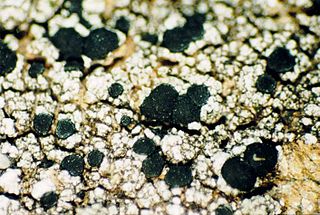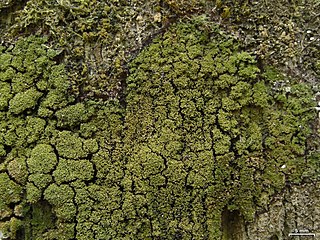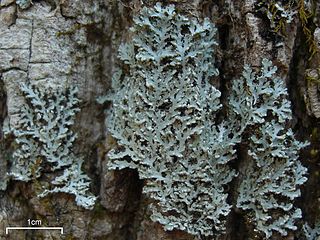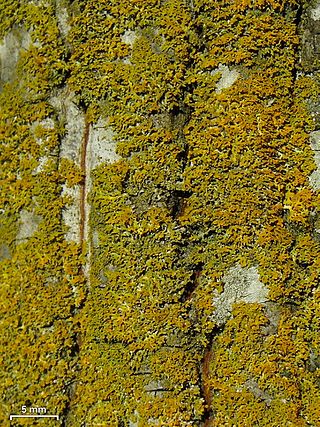
The Lecanoraceae are a family of lichenized fungi in the order Lecanorales. Species of this family have a widespread distribution.

Phyllopsora is a genus of lichen-forming fungi in the family Ramalinaceae. It was circumscribed by Swiss botanist Johannes Müller Argoviensis in 1894, with Phyllopsora breviuscula assigned as the type species.

Micarea is a genus of lichenized fungi in the family Pilocarpaceae. The widely distributed genus contains 126 species and new species are described actively. Species in the genus are crustose lichens and their photobiont is a single-celled green alga.
Cratiria is a genus of lichen-forming fungi in the family Caliciaceae. The genus has a widespread distribution, especially in tropical regions, and contains about 20 species. The genus was circumscribed by Austrian lichenologist Bernhard Marbach in 2000, with Cratiria lauri-cassiae assigned as the type species.

Amandinea is a genus of lichenized fungi in the family Caliciaceae. Genetic studies indicates that the genus Amandinea and Buellia are the same, although this is not widely accepted.

Heterodermia is a genus of lichenized fungi in the family Physciaceae. The genus has a widespread distribution, especially in tropical regions, and contains about 80 species.

Pyrrhospora is a genus of lichen-forming fungi in the family Lecanoraceae. The genus was circumscribed by German lichenologist Gustav Wilhelm Körber in 1855, with Pyrrhospora quernea assigned as the type species.
Eremastrella is a genus of lichen in the family Psoraceae. The genus was circumscribed by the lichenologist Stefan Vogel in 1955, with Eremastrella tobleri assigned as the type species.

Rhizocarpon is a genus of crustose, saxicolous, lecideoid lichens in the family Rhizocarpaceae. The genus is common in arctic-alpine environments, but also occurs throughout temperate, subtropical, and even tropical regions. They are commonly known as map lichens because of the prothallus forming border-like bands between colonies in some species, like the common map lichen.

Gallowayella is a genus of lichen-forming fungi in the family Teloschistaceae. It has 15 species. The genus was circumscribed in 2012 by Sergey Kondratyuk, Natalya Fedorenko, Soili Stenroos, Ingvar Kärnefelt, Jack Elix, and Arne Thell, with Gallowayella coppinsii assigned as the type species. The generic name honours New Zealand lichenologist David John Galloway (1942–2014).

Schaereria is a genus of lichen-forming fungi. It is the sole genus in the family Schaereriaceae, which itself is the only family in the Schaereriales, an order in the subclass Ostropomycetidae of the class Lecanoromycetes. Most Schaereria species are crustose lichens that live on rocks. Schaereria was first proposed by Gustav Wilhelm Körber in 1855 and was later taken up by other lichenologists despite periods of disuse.
Bibbya is a genus of fruticose lichens in the family Ramalinaceae.

Sporastatia is a genus of crustose lichens in the family Sporastatiaceae. It has four species. Sporastatia lichens are long-lived species that grow on siliceous or weakly calcareous rocks in arctic and alpine locales.

Carbonicola is a small genus of lichen-forming fungi. It is the sole genus in the monogeneric family Carbonicolaceae. The genus, which collectively has an almost cosmopolitan distribution, contains three squamulose lichens that prefer to grow on burned wood in temperate areas of the world.
Strangospora is a genus of lichen-forming fungi. It is the only genus in the family Strangosporaceae, which itself is of uncertain taxonomic placement in the Ascomycota. It contains 10 species.
Xanthoria yorkensis is a species of corticolous (bark-dwelling), crustose lichen in the family Teloschistaceae. Found in South Australia, it was formally described as a new species in 2009 by lichenologists Sergey Kondratyuk and Ingvar Kärnefelt. The type specimen, collected along the Maitland road in Yorke Peninsula, was found growing on Melaleuca trees in mallee scrub. The species epithet refers to its type locality, the only place the lichen is known to occur. Kondratyuk and colleagues proposed to transfer the taxon to the newly circumscribed Jackelixia in 2009, but this genus has not been widely accepted by other authorities.
Fulgidea is a genus of lichen-forming fungi in the family Umbilicariaceae. It has two species of squamulose lichens that grow on bark and on wood.
Melanolecia is a fungal genus in the family Lecideaceae. It contains the single species Melanolecia transitoria, a saxicolous (rock-dwelling) crustose lichen.











